Interview | John Duffin
We are delighted that John Duffin has found time to talk to us before the opening of his solo exhibition City Noir : John Duffin’s London in Paint and Print at our Ealing gallery from October 23rd.
In this fascinating interview John talks about his journey from working in Cumbria as draughtsman to living in London as an artist and provides insights into what inspires him, along with explaining his working practices and technical skills. His exhibition will consist of 60 prints and paintings and will include a range of new paintings of London train and tube stations and some large panoramic paintings showing views of London from highpoints in Greenwich and Primrose Hill along with a large ink drawing of Pitzhanger Manor in very dramatic weather!
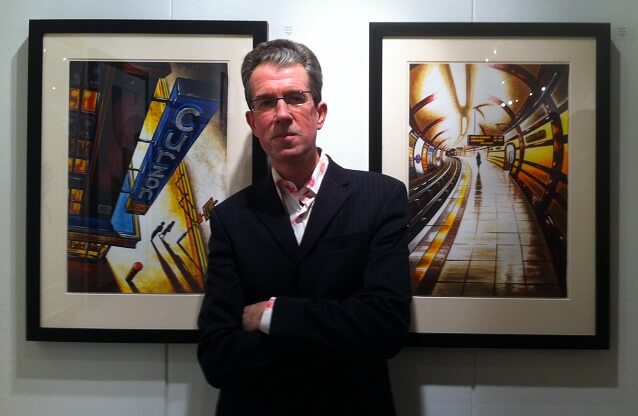
John Duffin, you are well respected as an artist for your distinctive style and etching skills demonstrating a great talent for line drawing and indeed in your early career you worked for 4 years as a Ship’s Draughtsman at Vickers Shipbuilding & Engineering Ltd in Cumbria. What prompted you to make the move from traditional employment to the life of an artist and what skills have you taken from this experience into your work – we would assume attention to detail for a start!
“I left school at 16 under pressure from my father who saw an apprenticeship in the drawing offices as a Ship Draughtsman and Naval Architect as a more secure life than studying A-levels and attending university. From the first day I entered the drawing offices I knew I had made a terrible mistake; I did not belong there and yearned for art education. I was unfortunately in a regime that it was difficult to get out of without major disruptions at home so drawing deeply upon my stoical nature I decided to spend the last of my teenage years working in the naval architects offices by day and study for A levels at night school. A far from easy time for me; it was a long four years in the drawing offices. I went in naive and youthful at 16 and left as a trade union activist and experienced working man at 20. When I handed my notice in it was seen as unbelievable by my peers and work colleagues as I was earning a lot of money and had a job that would have kept me working all of my life and in industries all over the world. To leave it to be a fine art student on a government grant looked insane!
Yet I did learn a lot in the world of industry and working 40 hours in an office per week topped up with 9 hours evening classes gave me a work discipline that has endured and allowed meet many exhibition deadlines.
“It also meant that I was drawing forms and shapes in first angle and third angle projection and learning how to visualize space in an architectural manner of seeing. This would subconsciously return to me later in life when my work became more concerned with architecture and physical space in urban environments.”
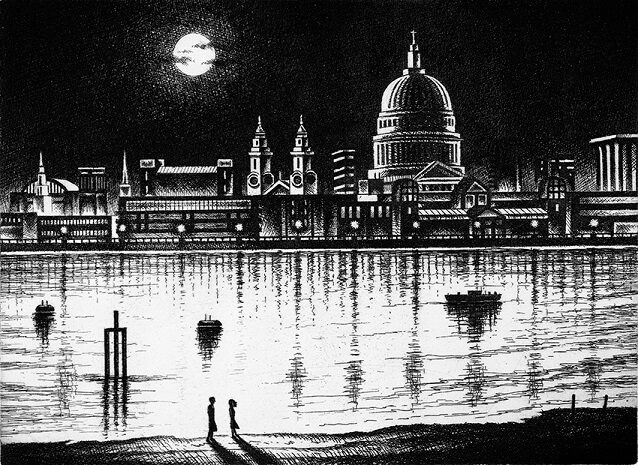
When did you move to London and what impact did this have on your life?
“I was accepted at 5 different art colleges but held out for a place at Goldsmiths’ in London, having been informed by a night school painting tutor that it was a course which had no restrictions and most importantly was in London.
I arrived in London in 1985 during the second wave of inner city riots in Brixton; the cab from Euston to Camberwell (the site of Goldsmiths’ College) had to go through a Police cordon as the area was under siege and Police lockdown, I knew then that life was going to be different…
My work is now in collections including Ashmolean Museum Oxford, Museum of London, BBC, Southbank Centre, National Football Association, Guildhall Library London and many other public collections.”
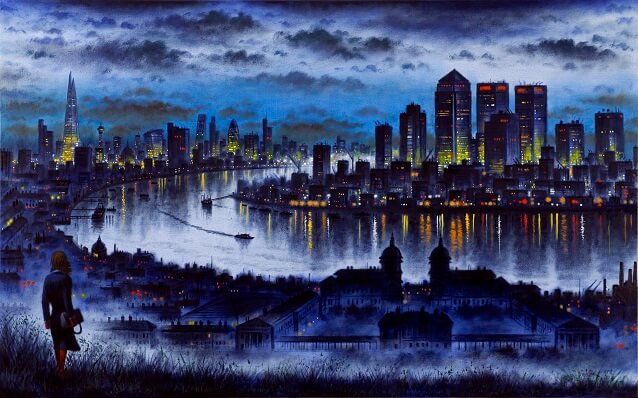
What was your experience of being an art student and how do you think this differed from someone who came straight from school?
“I was a student at Goldsmiths’ College where I would study Fine Art alongside Damien Hirst, Gary Hume, Ian Davenport, Fiona Rae, Sarah Lucas and the group of artists that became known as YBA’s. Along with them I was taught by Michael Craig Martin. It was challenging and rigorous college that unbeknownst to us at the time was fermenting the sea change in the visual arts in the UK via it’s radical teaching policy which treated all students as serious young artists and critiqued their work in an uncompromising manner. I learnt a lot there, chiefly how to make strong work that you could robustly defend against criticism and could hold it’s own in any artistic company. I think all my generation from Goldsmiths’ are still informed and shaped by those years as students in the mid 80’s.”
Despite settling in London, your love of your hometown Barrow-in-Furness and the wider area of Cumbria seems to still run through your blood. How important is a sense of home to you? Do you return often and what is it that continues to appeal?
“I make work about the places I live in; I continue to make work about my hometown as I still visit regularly and it acts as a foil to my paintings and prints about London. I have been in London for 30 years now and the city continues to engage me artistically and professionally, the longer I am here the more there is to say about it.”
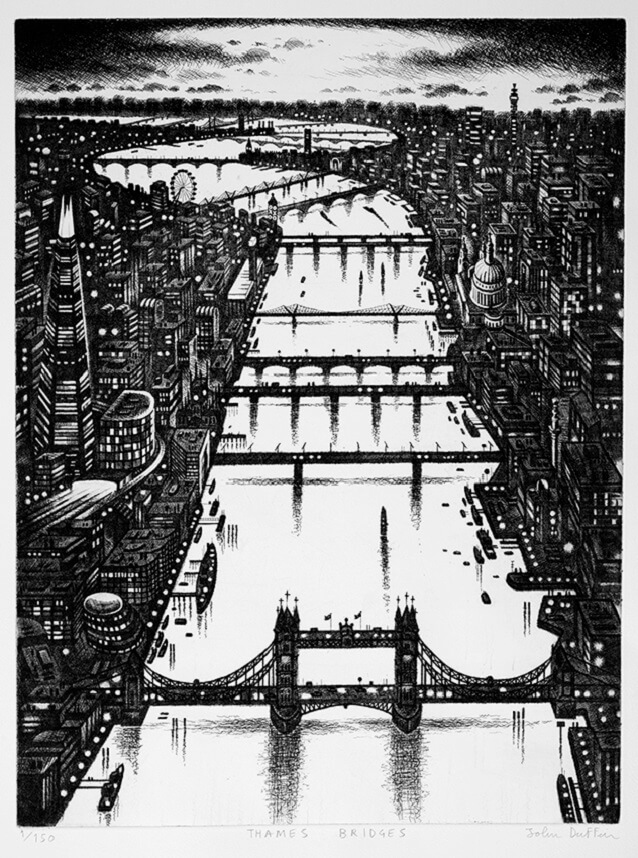
The majority of your work captures contemporary urban life. What is your starting process?
“My prints are a result of drawing, looking, thinking, imagining and remaking what I have seen in the world. Into that depiction comes my technical drawing background, love of film noir and graphic novels and my own experiences living in London for several decades. My training in industry meant that I was at a drawing board 40 hours a week and in an artistic sense I subconsciously remain a draughtsman in the way in which I approach making work.
My subject matter has been influenced by the urban environments I have always lived in, the shipyard, ironworks and steelworks of Barrow-in-Furness gave me a subconscious interest in the shapes, forms and lighting created by the man made world. Several decades in the architectural plethora of London allowed these ideas to develop and grow. The places I depict are often locations that hold memory or a fleeting moment for me, these sites are revisited later and the sense of place and moment are what I am trying to evoke in my prints.
My early student work showed large figures with cityscape backgrounds. Over the years the figures have decreased in size, the walls and buildings have come to dwarf them as the camera in my mind’s eye pulls back, twists and focuses on the scene from above, below or afar. The angle of view, lighting, positioning of figures and choice of architectural details are all considered and edited in order to create the finished image. Train platforms, Tube station entrances, cinema fronts and wet streets occur in the prints, places of transience and meeting or departure.
My work is a flaneur’s view of the city; I am involved within it yet also slightly apart, the prints are observations and recollections of the exchanges, relationships and anime of urban living. As a person who came to live in London as a student and remained there I have unconsciously remained slightly outside of the city when making work, my default position seems to remain that of the detached observer. At times the isolation and alienation of the city are present in my work and these themes reoccur throughout my prints. The etchings and paintings are in a way an ongoing series, like film stills or pages from a graphic novel, a sense of narrative but no clear beginning or ending.”
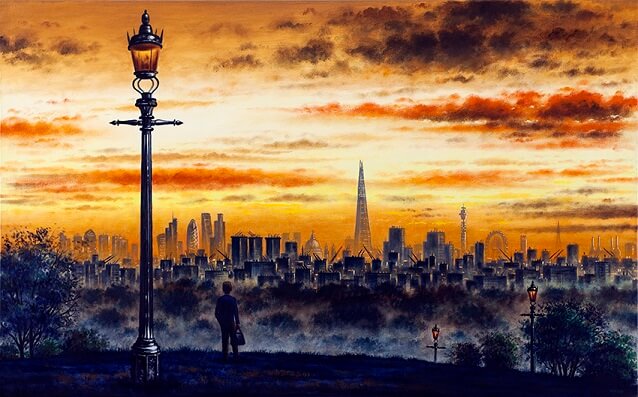
We understand that you mainly work from sketches; do you always take your sketch book with you, on the look-out for inspiration, or do you have a clear idea of what you want to capture before you start?
“My prints are the product of many hours spent walking the city streets and drawing with a 4B pencil in sketchbooks and on scraps of paper. I try to simplify and pare down what is in front of me, mentally preparing compositions that could be prints later. The subjects are places that have played a role in my life at some point, sites of meetings, departures, good and bad memories, old friendships and lost loves, all subconsciously resonate in the here and now in the selection, depiction and remaking of the place from those feelings and emotions. This life experience is what I am really after in my prints, I want the mood, atmosphere and sensation of what that place and time was and is to me, the train stations, tube platforms and public buildings of London have been witnesses and advocates in my life and when working on them as subjects all of that life experience plays a part in the making of the image.
In the studio I draw on my years in the Shipyard Drawing Office and utilize my naval architecture training to begin to distort and depict the subject matter to become not only what I saw but more importantly what I felt, creating urban dramas from concrete, electric lighting and the myriad of human beings that inhabit the spaces. The figures in my work always come at the end of the composition, they give meaning and resonance to the spaces and I deliberate for weeks on the placing of a lone figure, a cast shadow or wet reflection, every mark has to be just right to make the composition act on the viewer’s psyche as the original location acted upon mine.”
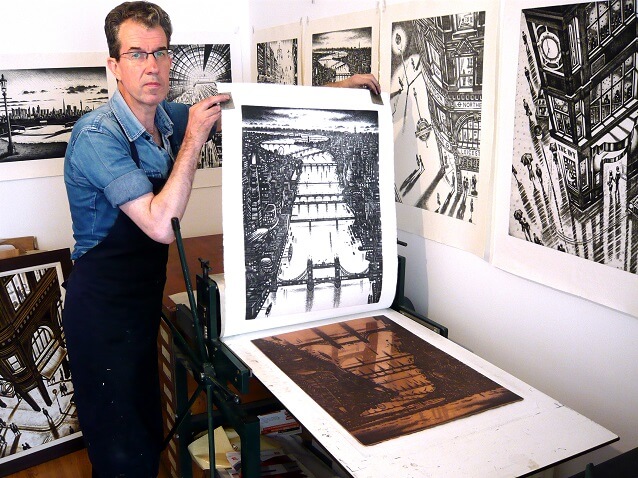
Can you tell us a bit about the techniques you use, especially in your prints?
In the shipyard I had begun to make drawings everyday of what was around me and had been advised by a local artist to learn to draw using a black biro as this was a great discipline because the marks could not be removed and you therefore had to be decisive and confident with your drawing. I therefore began to draw extensively with black bic biro’s, using cross hatching to create shading and form, these marks translated perfectly into cross hatching on wax covered plates, it was as if I had been training for four years in preparation for drawing on an etching plate.
I use a variety of methods when making work but all begin with drawing. If I can work in front of a subject in an outdoor space that is where I begin, working on several dark pencil drawings of the subject from different angles. These are then taken back to my studio and are laid out and viewed – there should be enough information in the drawings for me to begin to investigate the space in a new drawing. At this point I create many small views of the subject from different angles and with different light sources and at different times of day, creating a range of small potential compositions. I eventually fix on the one that has most of what I intuitively felt and valued about the space, this design is then blown up on a photocopier or scanner to a 76 x 56 cm size or similar and transferred onto a piece of 300gm watercolour paper. I work this drawing up in charcoal or washes of black ink, refining, revising and developing the image as I work. Once this is achieved I may then make a colour study in watercolour or even an acrylic or oil painting of the subject, each one slightly different in terms of the view, angle or mood.
Once I have investigated the subject in this range of media I can begin to select the viewpoint that will work best for the print. This long procedure bears fruit at this point as when I begin work on the print I know the subject very well and can approach the image with confidence and speed. The prints I feel are most successful are the ones that are made relatively quickly (10-12 days studio work on the actual plate) and directly. Time is relative in printmaking and my works are labour intensive, being created from long periods of drawing on the plate followed by a day of biting in the acid bath and then a proof taken on the press. Once I have the proof I know immediately what else is required, another one or two drawing sessions on the plate and biting in acid and the image should be there. My works are planned carefully over a long period and then realized in a sustained time of print studio work.
As a printmaker who uses etching and draws through a wax hard ground onto copper plates I have in my time scraped back, stopped out areas, overbitten and underwiped plates, yet the freshest works arrive from a very direct and pared down drawing procedure using hard ground which feels fresh and concise. Having made so many studies and preparatory drawings the creative printmaking process itself is a calligraphic activity that through my years of practice and skill reveals the image on the copper as I saw it in my mind’s eye whilst first drawing the subject.”
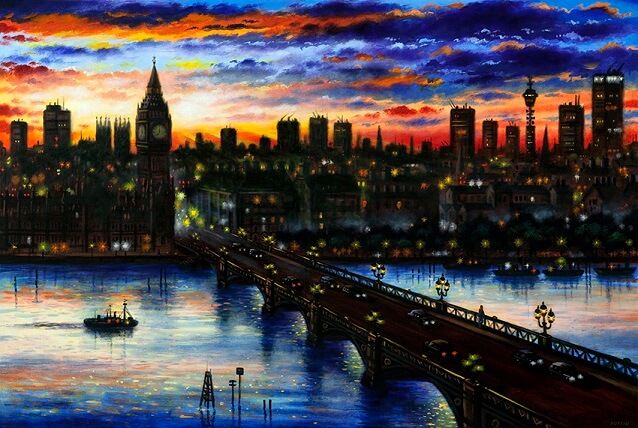
Where do you work?
“I work in a Victorian house in south London that has etching press, plan chests, drying racks, acid baths etc and a painting studio space.”
What are your influences? You have been compared to LS Lowry and Edward Hopper along with references to Marvel and DC Comics– what is your view on these wide ranging comparisons?
“I began life looking at graphic art in comics as visual stimulation in a small northern town was non existent, so my early inspiration was comic books. At 6 or 7 years old I began to collect comics that were reprints of classic American marvel comics, the strange sinewy drawings made by Steve Ditko of Spider-Man, Jack Kirby’s creations such as The Fantastic Four, The Hulk & Thor were all spell binding to me. I bought comics solely for the artwork, learned the names of the artists and began to differentiate early, middle and late periods of each artists work. This taxonomy for identifying mark making would remain with me and later be seamlessly transferred to viewing prints, drawings and paintings in national collections.
My work has been seen as being within a tradition that refers back to Hopper and Lowry, they are influences on my work and I am trying to speak of the times I am living through as they did of their times.”
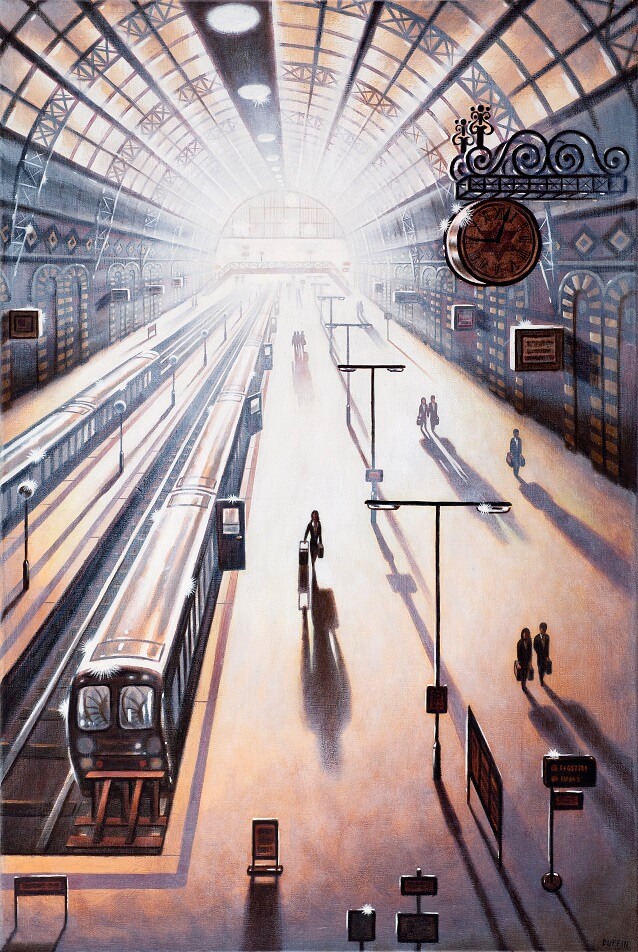
John Duffin’s exhibition City Noir : John Duffin’s London in Paint and Print runs at For Arts Sake Ealing Gallery from 23rd October – 22nd November 2015.
A common theme in the works is transience and travel – the paintings show the river Thames, tube stations and railway platforms, all points of departure and arrival. The figures in the paintings are either on the move or contemplating movement, they are travellers seeking something other in their lives.
To attend the private view on Thursday 22nd October please email [email protected]
For more images of John Duffin’s prints and paintings see his page here.





